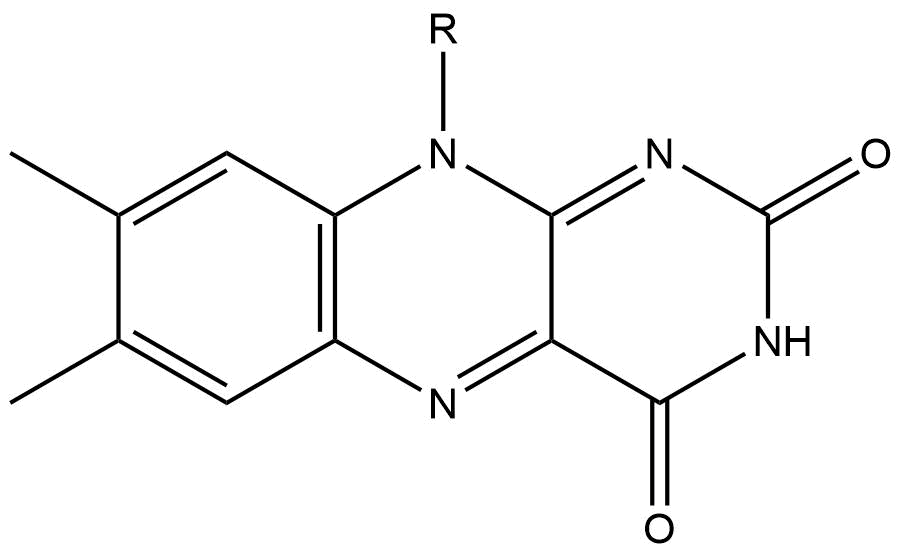Isoalloxazine Structure on:
[Wikipedia]
[Google]
[Amazon]
Isoalloxazine is the structural foundation of 

flavins
Flavins (from Latin ''flavus'', "yellow") refers generally to the class of organic compounds containing the tricyclic heterocycle isoalloxazine or its isomer alloxazine, and derivatives thereof. The biochemical source of flavin is the yellow B ...
such as riboflavin
Riboflavin, also known as vitamin B2, is a vitamin found in food and sold as a dietary supplement. It is essential to the formation of two major coenzymes, flavin mononucleotide and flavin adenine dinucleotide. These coenzymes are involved in ...
(vitamin B2) and is a heterocyclic compound
A heterocyclic compound or ring structure is a cyclic compound that has atoms of at least two different elements as members of its ring(s). Heterocyclic organic chemistry is the branch of organic chemistry dealing with the synthesis, proper ...
. It has a tricyclic
Tricyclics are cyclic chemical compounds that contain three fused rings of atoms.
Many compounds have a tricyclic structure, but in pharmacology, the term has traditionally been reserved to describe heterocyclic drugs. They include antidepr ...
structure which means it has three interconnected rings of atom
Atoms are the basic particles of the chemical elements. An atom consists of a atomic nucleus, nucleus of protons and generally neutrons, surrounded by an electromagnetically bound swarm of electrons. The chemical elements are distinguished fr ...
s and is a tautomer
In chemistry, tautomers () are structural isomers (constitutional isomers) of chemical compounds that readily interconvert.
The chemical reaction interconverting the two is called tautomerization. This conversion commonly results from the reloca ...
of alloxazine. The structure is formed by primary-secondary aromatic o-diamines and they are a high-melting crystalline substance. The R-group is used to attach various flavin groups It has a similar structure to pteridines
A pteridine is a bicyclic heterocyclic system with two nitrogen atoms at positions 1 and 4 in ring A, and two nitrogen atoms at positions 1 and 3 in ring B. Pteridines constitute a large group of heterocyclic compounds containing a wide variety ...
which has two interconnected rings. Isoalloxazine was first obtained in 1934 by Richard Kuhn
Richard Johann Kuhn (; 3 December 1900 – 31 July 1967) was an Austrian-German biochemist who was awarded the Nobel Prize in Chemistry in 1938 "for his work on carotenoids and vitamins".
Biography
Early life
Kuhn was born in Vienna, Austria ...
an Austrian-German biochemist and lab mates. 
Isoalloxazine ring
Isoalloxazine rings can exist in differentredox
Redox ( , , reduction–oxidation or oxidation–reduction) is a type of chemical reaction in which the oxidation states of the reactants change. Oxidation is the loss of electrons or an increase in the oxidation state, while reduction is t ...
and ionization
Ionization or ionisation is the process by which an atom or a molecule acquires a negative or positive Electric charge, charge by gaining or losing electrons, often in conjunction with other chemical changes. The resulting electrically charged at ...
states depending on the chemistry of FMN and FAD
A fad, trend, or craze is any form of collective behavior that develops within a culture, a generation, or social group in which a group of people enthusiastically follow an impulse for a short time period.
Fads are objects or behaviors tha ...
associated with it. Using the redox-active isoalloxazine system, FAD
A fad, trend, or craze is any form of collective behavior that develops within a culture, a generation, or social group in which a group of people enthusiastically follow an impulse for a short time period.
Fads are objects or behaviors tha ...
and FMN are able to do one and two electron
The electron (, or in nuclear reactions) is a subatomic particle with a negative one elementary charge, elementary electric charge. It is a fundamental particle that comprises the ordinary matter that makes up the universe, along with up qua ...
transfer reactions and also be coupled with proton
A proton is a stable subatomic particle, symbol , Hydron (chemistry), H+, or 1H+ with a positive electric charge of +1 ''e'' (elementary charge). Its mass is slightly less than the mass of a neutron and approximately times the mass of an e ...
transfers.

References
{{reflist Heterocyclic compounds with 3 rings Nitrogen heterocycles Pteridines